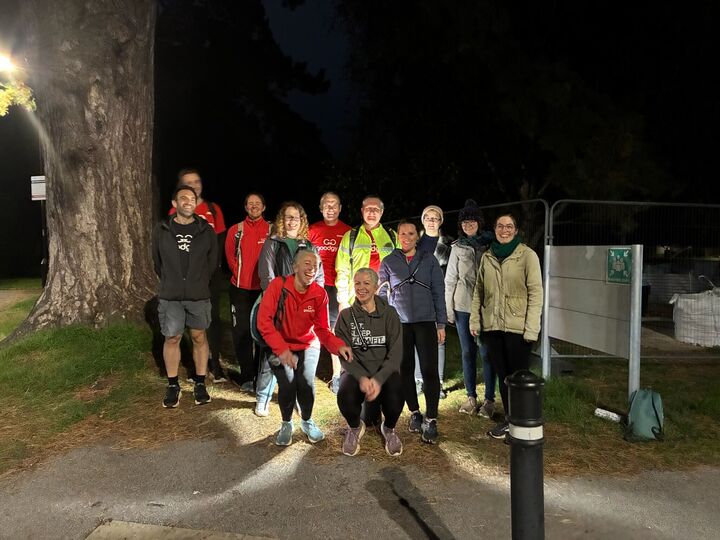Goodgym Coordinator for Oxford. Trail runner, often muddy.
652
Good Deeds
Workouts
2531
Cheers given
15311
Cheers received
2808
Verified member
Area activator
Doing good since October 2018
1 Month Streak
69 Month Streak
































Block or report Anwen Greenaway
Anwen Greenaway's next session
Oxford
📍Magdalen Arms OX4 1SJ
The Porch Day Centre

Latest activity
Anwen Greenaway went on a group run
Wed 3rd Dec at 6:00pm
Oxford Report written by Anwen Greenaway
'Tis the season to litter pick the streets of Oxford, so to Headington we headed for an evening of nattering and trash clearing.
We focused on the area surrounding the Oxford Brookes Headington campus, finding plenty of the usual suspects; cans, bottles, crisp packets etc. We were just chatting about how rarely we find pants these days, after a spate of unearthing them on almost every litter pick, when lo and behold Ben spotted a pair hooked on the railings. It's like we manifested them.
1 hour, several heavy bags full of trash, and a potential new recruit later, we deposited our haul for collection and headed off home to warm up.
Anwen Greenaway went on a group run
Wed 26th Nov at 6:00pm
Oxford Report written by Bethan Greenaway
This evening a gaggle of Goodgymers turned into Christmas Elves.
Gathering in a cosy Oxford pub (chips were indeed consumed) we scribed Christmas cards to be distributed around care homes in the UK.
Heads were scratched and inspiration was found in the form of doodles, Christmas Cracker jokes, poems and sharing of favorite decorations and food.
These tasks can feel a bit daunting sometimes, where to start when writing to a stranger? But we amassed a brilliant stack of cards to be sent off for distribution. I'm sure that they will spread a lot of joy at a time of year that can be very lonely for some.
Thank you Goodgym Elves!!
Anwen Greenaway went on a group run
Wed 19th Nov at 6:00pm
Oxford Report written by Anwen Greenaway
Our winter food bank clean got going last night; a very welcome indoor task given the sudden chill!
Each winter we do a session roughly once a month to give the food bank a thorough clean. It's hard for their usual team of volunteers to take time away from packing food parcels to do a really thorough clean, so GoodGym taking over the task helps them focus on getting food out to people in need.
This month we cleaned fridges, emptied food waste, cleaned the wall behind the food waste crates, swept & mopped in the kitchen. In the main hall we moved the shelving along the wall closet to the car park, swept, mopped, cleaned the shelves.
Anwen Greenaway went on a group run
Wed 5th Nov at 6:00pm
Oxford Report written by Anwen Greenaway
The litter around West Oxford Community Centre has been quite heavy in the past, so we try to get out there a couple of times a year for a clean up. With the whizz-bang of fireworks all around we set off for our autumn session. Despite some Halloween detritus, and some unusual finds (a French dictionary, burglar alarms, mini-bedspread, pants), we were pleasantly surprised by the state of the litter. We collected far less than usual - good job West Oxford!
Hide comments (2)
Fri 7th Nov at 4:59pm
congrats on 400 good deeds Bethan - amazing achievement!! 👏
Sun 9th Nov at 4:42pm
Thanks Jack!
Anwen Greenaway went on a community mission
Sat 1st Nov at 10:00am
Oxford Report written by Bethan Greenaway
Today we returned to Littlemore for tea and cake, oh sorry, I mean helping in the village hall garden.
The village hall in Littlemore has a lovely garden which requires a bit of TLC every now and then. A nettle patch created to attract bees and butterflies had encroached on a flower bed, weeds had popped up in a lawn area, various plants needed pruning and leaf piles created.
Armed with tools, and luxury of all luxury at a gardening task, kneeler pads we set to work and after a couple of hours the space was looking ship shape and shiny.
We then were treated to tea, cake and chat in the village hall - glorious!
Anwen Greenaway went on a group run
Wed 29th Oct at 6:00pm
Oxford Report written by Bethan Greenaway
Today we donned our headtorches and high-viz and beat the curfew by delivering flyers for our friends at Flos.
The flyers were mostly for their wonderful refill shop - encouraging people in the local area to shop local, support a local business and reduce their single use plastics.
Meg brought an excellent flyering tool in the form of a trusty spatula and showed us a "fold and shove" process that protects fingertips and knuckles from letterboxes! Something to remember for our next flyering task!
Loading...